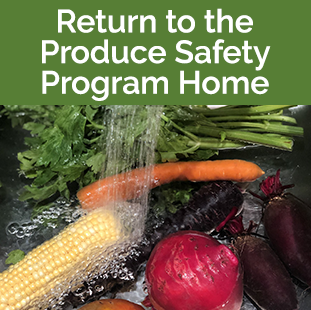Produce Safety Resources
Food Safety Partner Websites and Resources
- Produce Regulation and Licensing Guidance
- Montana Local Food Choice Act Guidance
- Farmer’s Market Guidelines
- Additional info on Cottage Foods and Farmer’s Markets
- DPHHS Environmental Health and Food Safety Section
- Food & Ag Development Centers
- Montana Manufacturing Extension Center
- MSU Extension Food Safety
- Department of Livestock Meat, Milk, and Egg Inspections
Frequently Asked Questions
Some farms may be exempt from the Produce Safety Rule. Exemptions include produce that is: grown for personal consumption; will receive commercial processing; or is rarely consumed raw (such as potatoes). Additional exemptions are for farms that have less than $33,297 in average annual produce sales. Complete the Farm Status Determination form to determine whether your farm is eligible for an exemption from the rule. Farms must verify their Produce Safety Rule status annually to qualify for an exemption or qualified exemption.
Inspections of all farms subject to the rule, regardless of size, have already begun. The Produce Safety Program at Montana Department of Agriculture offers free On-Farm Readiness Reviews to assist covered farms in preparing for their first inspection. Learn more about what to expect during an On-Farm Readiness Review and how to request one.
The Food Safety Modernization Act does not take the place of the USDA Good Agricultural Practices (GAPs) & Good Handling Practices (GHPs), and a GAP audit is not sufficient to comply with the FSMA Produce Safety Rule. However, being GAP certified or having a farm food safety plan will make it easier for you to meet these requirements. Depending on the program you use, you may find that your audit requirements are higher than the FSMA Produce Safety Rule requirements. Contact the Montana Department of Agriculture if you have more questions.
No, you are not required to have an on-farm food safety plan under the FSMA Produce Safety Rule. However, having a plan is an excellent way to organize and manage your safety policies and procedures. Additionally, if you are exempt from the rule, having a food safety plan to show your buyers can demonstrate your commitment to safe produce. Multiple online resources exist to help you create a plan. Templates and guides.
The harvest and post-harvest agricultural water requirements have not changed.
In 2024, the FDA finalized and published the revised requirements for pre-harvest agricultural water. The revised requirements replace the previous microbial quality criteria and testing requirements with a systems-based, pre-harvest agricultural water assessment.
More information and resources on agricultural water can be found on our Agricultural Water page.
As a consumer, you should still take measures to reduce microbial contamination on fruits and vegetables at home. Steps include:
- Refrigerate perishable fruits and veggies at 40 degrees or below.
- Be mindful not to cross contaminate raw meat or seafood products with produce
- Wash your hands with soap and water before preparing fresh produce
- Wash fruits and vegetables with water before eating or cutting



